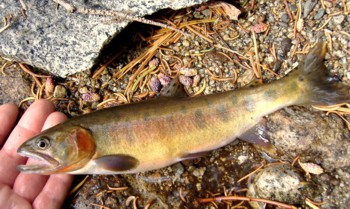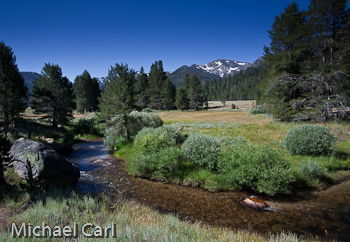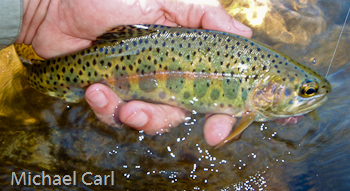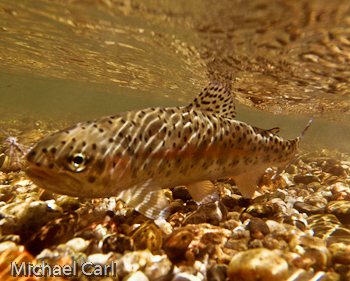Silver King Creek Carson-Iceberg Wilderness
The Silver King Creek drainage is located on the eastern slope of the Sierra Nevada Range, in Alpine County, California. Its upper reach provides habitat for the Paiute cutthroat trout.

Photo of rare Paiute cutthroat contributed by Eric Herve.
The Paiute currently occupies about 12 miles of the Silver King drainage above Llewellyn Falls and above a barrier in Corral and Coyote Creeks. A major effort led by CDFG is underway to re-introduce Paiute cutthroat to an additional six mile stretch of Silver King Creek below Llewellyn Falls. Lawsuits and a large snowpack in 2011 have delayed the removal of the non-native rainbow trout in this lower stretch.

Silver King Creek is a tributary of the East Fork Carson River. The creek originates at 9600 feet elevation in the southernmost portion of the drainage, and flows north through three distinct valleys for about 14 miles where it meets the East Fork Carson River. Between the headwaters and the confluence of Silver King Creek with the East Fork Carson River, eight tributaries, three above and five below Llewellyn Falls, join Silver King Creek. Llewellyn Falls, at an elevation of 8000 feet, is located at the head of Lower Fish Valley.

From its source, Silver King Creek flows precipitously for 2 miles before gradually descenting to Upper Fish Valley just above the mouth of Fly Valley Creek. For 1.5 miles, through Upper Fish Valley, it's a typical meandering meadow creek. Several soda springs occur in the valley, with some seeping directly into the stream. From the southeast, Four Mile Canyon Creek enters 1.2 miles above Llewellyn Falls (pictured below), while Bull Canyon Creek joins the mainstem from the west 0.5 mile above Llewellyn Falls.

At the lower end of Upper Fish Valley, the stream gradient increases through a sparsely forested section before reaching Llewellyn Falls. In Lower Fish Valley, two small tributaries enter the mainstem from the west: Tamarack Lake Creek, located 0.7 mile below Llewellyn Falls, and another short, unnamed tributary. Long Valley, only 0.9 mile long, is the shortest of the three valleys. No tributaries enter this section of Silver King Creek. Between Lower Fish Valley and Long Valley the gradient increases. Below Long Valley, Tamarack Creek enters Silver King Creek 0.4 mile below Long Valley and Coyote Valley Creek enters 0.6 mile farther downstream.
Several miles below the mouth of Coyote Valley Creek, Silver King Creek descends through Silver King Canyon and emerges from the canyon in the vicinity of Snodgrass Creek. Upstream from Snodgrass Creek, in the canyon, a series of falls present a barrier to fish species that occur downstream. Silver King Creek from its confluence with Snodgrass Creek runs about 3.4 miles until reaching the East Fork Carson River.

What's Next for the Silver King Below Llewellyn Falls?
The next phase of restoration will extend the range of the Paiute trout below Llewellyn Falls to an additional six miles of native stream. The same successful methods will be used as in 1993. Most of the hybridized fish will be removed by electro-shocking. The fish will be moved downstream below the barrier falls for angling. Any remaining hybrids will be eradicated from the six miles of stream. Healthy Paiute trout will then be reintroduced to their original habitat. A successful reintroduction of the Paiute Cutthroat Trout to the entire length of Silver King Creek could ultimately result in the Paiute Cutthroat being the first fish species removed from the Federal Endangered Species List.

